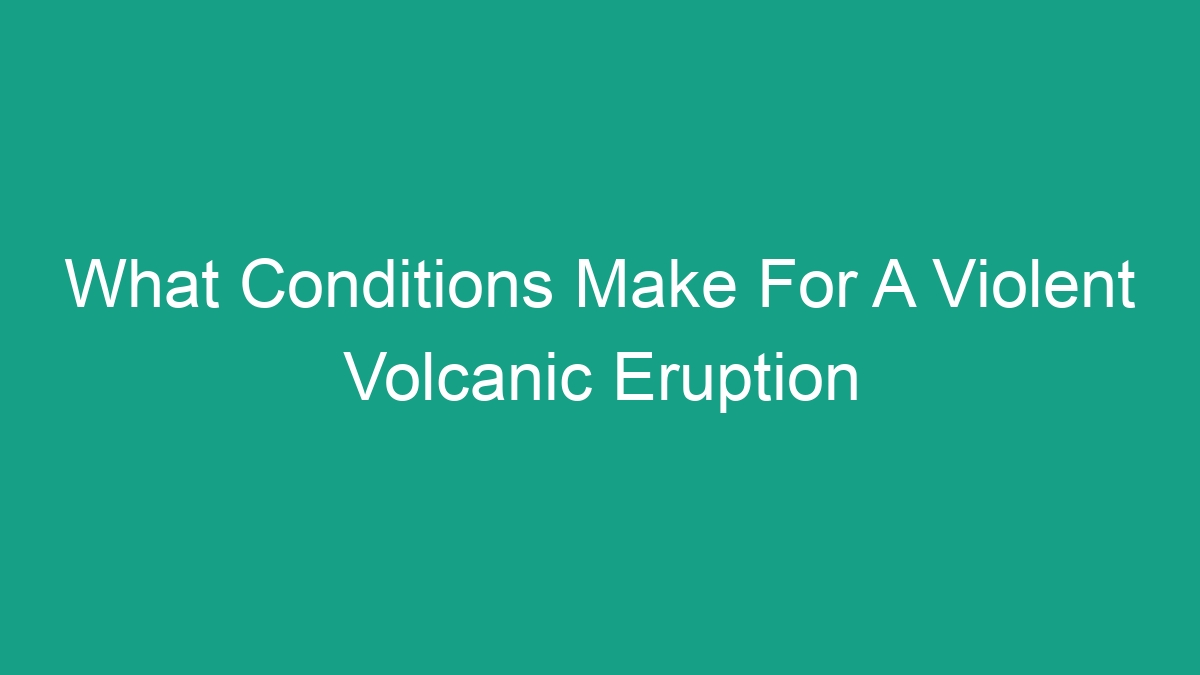
Overview of a Volcanic Eruption
A volcanic eruption occurs when molten rock, ash, and gases escape from an underground magma chamber through a fissure or vent in the Earth’s crust. The severity of a volcanic eruption can vary widely, from relatively gentle lava flows to explosive blasts that can cause widespread devastation.
Conditions Leading to Violent Volcanic Eruptions
Magma Composition
The composition of the magma within a volcano plays a significant role in determining the explosiveness of an eruption. Highly viscous (sticky) magma with high silica content tends to trap gases, leading to a buildup of pressure within the volcano. This can result in explosive eruptions as the pressure is suddenly released. In contrast, low-viscosity magma with lower silica content allows gases to escape more easily, leading to less explosive eruptions.
Volcano Elevation and Pressure
The height of a volcano and the pressure within its magma chamber also contribute to the likelihood of a violent eruption. Highly elevated volcanoes have a greater potential for explosive eruptions due to the increased pressure exerted by the overlying rock. This pressure can lead to a more forceful release of magma and gases during an eruption, resulting in greater devastation.
Volcanic Gases
Volcanic gases play a crucial role in the explosiveness of an eruption. Carbon dioxide, water vapor, and sulfur dioxide are common volcanic gases that can significantly impact the behavior of a volcano. The buildup of these gases within the magma chamber can lead to increased pressure, contributing to explosive eruptions. Additionally, the release of these gases during an eruption can also have widespread environmental effects, including acid rain and air pollution.
Presence of Water
The presence of water can also influence the explosiveness of a volcanic eruption. When water comes into contact with magma, it can cause a rapid expansion of steam, adding to the buildup of pressure within the volcano. This can result in more violent and explosive eruptions, particularly in areas with high groundwater or proximity to bodies of water.
Categories of Volcanic Eruptions
Volcanic eruptions are commonly categorized based on their explosiveness and the types of materials expelled. The most violent and explosive eruptions fall into the category of Plinian eruptions, named after the Roman historian Pliny the Younger. These eruptions are characterized by their massive eruption columns and extensive ash fall. In contrast, Hawaiian eruptions are relatively gentle, with the outpouring of lava being the primary form of activity.
Impact of Violent Volcanic Eruptions
Violent volcanic eruptions can have far-reaching and devastating effects on both the local environment and global climate. The immediate impacts may include widespread destruction of infrastructure, loss of life, and displacement of communities. In addition, the release of large quantities of ash, gases, and aerosols can have long-term effects on climate patterns, leading to global cooling and disruptions to air travel and agriculture.
Preparation and Mitigation
Given the potential for catastrophic consequences, it is crucial to have effective preparation and mitigation strategies in place for areas at risk of violent volcanic eruptions. This may include early warning systems, evacuation plans, and the development of resilient infrastructure to withstand the impacts of eruptions.
FAQ
What are the warning signs of a potential volcanic eruption?
Volcanic eruptions are often preceded by a variety of warning signs, including increased seismic activity, ground deformation, changes in gas emissions, and the formation of new vents. Monitoring these signs using specialized equipment and techniques can help scientists predict and prepare for potential eruptions.
Can volcanic eruptions be accurately predicted?
While significant progress has been made in monitoring and understanding volcanic activity, accurately predicting the precise timing and scale of an eruption remains a considerable challenge. However, ongoing advancements in technology and research are improving our ability to forecast volcanic eruptions with greater accuracy.
How can individuals and communities prepare for a volcanic eruption?
Preparing for a volcanic eruption involves developing a readiness plan that includes knowledge of evacuation routes, emergency supplies, and communication strategies. Engaging in community drills and staying informed about local volcanic hazards are crucial aspects of preparation.



